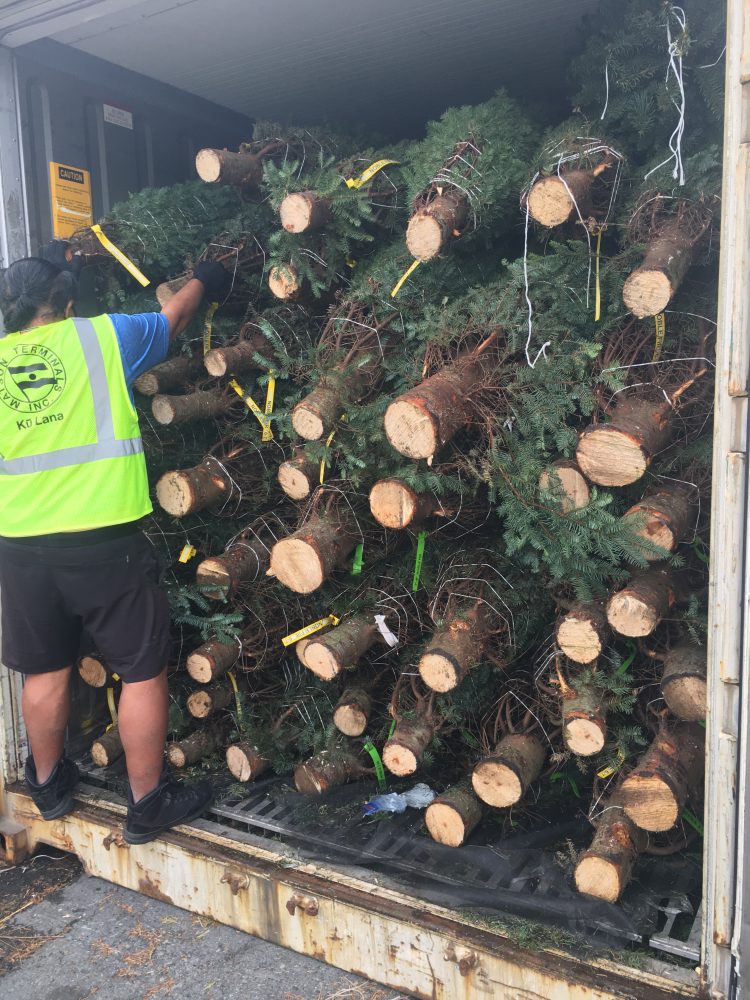Nothing heralds the holiday season like the Christmas tree, but did you know that most of Hawaiʻiʻs Christmas trees are not from here? This year, over 150 shipping containers are estimated to arrive in our State, equating to over 90,000 trees. About 99% of them are Douglas and Noble Firs, grown and shipped from Oregon. Invasive pests not known in Hawaiʻi may be lurking in their boughs, but the Hawaiʻi Department of Agriculture inspector elves remain on the frontlines to keep these harmful grinches out.

From field to living room, a Christmas tree goes through quite a journey to deck your halls. State Planned Regulatory Official (SPRO) for Hawai’i Department of Agriculture (HDOA), Helmuth Rogg, knows this all too well. Rogg served for 17 years as the SPRO for the Oregon Department of Agriculture before starting his position with HDOA last year. “Oregon is the number one Christmas tree producer in America and exports to over 36 countries”, Rogg said. “The process begins well before the holidays when Oregon inspectors check fields for infestations of specific pests, such as the Douglas Fir twig beetle. If there is an infestation, nothing in the field will be exported that year.”
After an eight-year growing period, trees are harvested on farms, then airlifted to a staging area to prevent excess amounts of mud from sticking to them. Once they land, they are gathered, cleaned, and baled. Oregon inspectors then check for pests by vigorously shaking trees and tapping their stumps on the ground to dislodge any hitchhikers before loading them into shipping containers. Before the container doors are closed, inspectors take out three random trees and shakes them. If anything falls out, the entire container is unloaded, and the whole process begins again.
After Christmas trees are loaded into their containers, they are shipped to Hawaiʻi and greeted by HDOA inspectors. Three trees will be pulled out of each container and shaken on a white tarp. If inspectors find any pests, the container is closed, sealed, and put on hold. The store that ordered the trees will either send the container back to its origin or pay HDOA to clean the trees in a sealed quarantine facility. This process can take up to half a day with ten inspectors, where all trees are unloaded, cleaned, and reloaded into a sanitized container before heading to the store.
This year, over 150 shipping containers are estimated to arrive in our State, equating to over 90,000 trees. About 99% of them are Douglas and Noble Firs, grown and shipped from Oregon. Invasive pests not known in Hawaiʻi may be lurking in their boughs.
Even with all of this effort, pests still manage to sneak in. The most common pests on Hawaiʻi Christmas trees are slugs and yellow jackets. In 2020, inspectors captured a live garter snake in a Christmas tree container. As long as trees are imported, the risk of accidental introductions remains. Still, Rogg reassures, “So far this year, only four out of the 150 containers that arrived needed to be cleaned by HDOA inspectors, or about 1% of Christmas tree arrivals.” Rogg does encourage the public to be vigilant, though. “If something hitchhikes on your Christmas tree, safely collect it in a zip-top bag, take a photo of it, place it in the freezer and report it to 643pest.org, where officials can identify it.”
Want to eliminate the risk of invasive imported hitchhikers altogether? Choose local. Kula Botanical Gardens is one of the largest Christmas tree growers in the State, with an assortment of upcountry grown Monterey Pines. Kula Kelly’s Farm in ʻŌmaʻopio boasts a small selection of Norfolk Pines. If you crave a family adventure and want to cut down your own tree, the Department of Land and Natural Resources issues collection permits for Monterey Pines, 15 feet or under, for a $20 fee. Lance DeSilva, Forest Management Supervisor with the Maui DLNR Division of Forestry and Wildlife, shares, “Kula Forest Reserve is the only State area on Maui allowed for Christmas tree cutting. If you would like to cut down your own Christmas tree, please give our office a call at (808) 984-8100.” Lastly, Alaheʻe is a native option with a similar growth pattern to a Christmas tree and does well in pots, so it can be potted up and used every year before planting in your yard. Another bonus? Itʻs tiny, white flowers are reminiscent of mock orange blossoms, providing good tidings and cheer well beyond the holidays.




